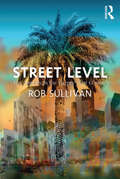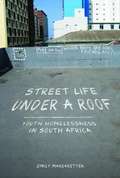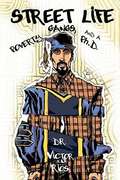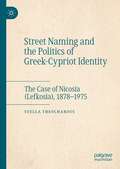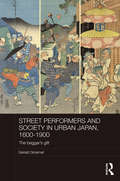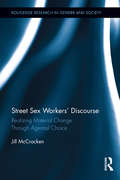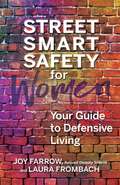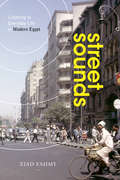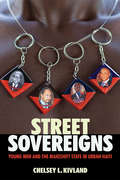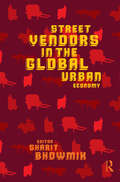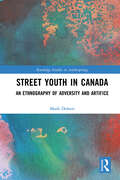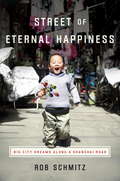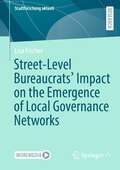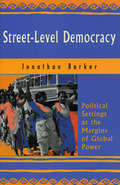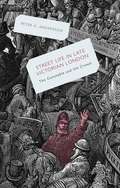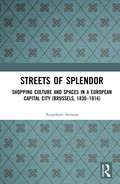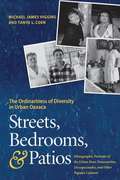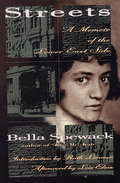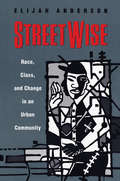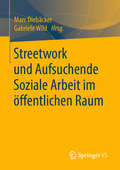- Table View
- List View
Street Level: Los Angeles In The Twenty-first Century
by Rob SullivanIn the latter part of the C20th, a series of seminal books were written which examined Los Angeles by the likes of Reyner Banham, Mike Davis, Edward Soja, Allen Scott, Michael Dear, Frederick Jameson, Umberto Eco, Bernard-Henri Levy, and Jean Baudrillard which have been hugely influential in thinking about cities more broadly. The debates which were generated by these works have tended to be very heated and either defensive or offensive in approach. A sufficient amount of time has since passed that a more measured approach to evaluating this work can now be taken. The first section of this book, 'Contra This and Contra That', provides such a critique of the various theories applied to Los Angeles during the last century, balancing the positive with the negative. The second part of the book is an investigation of L.A. as it exists on the ground today. While political, the theoretical stance taken in this investigation is not mounted as a platform from which to advocate a particular ideology. Instead, it encompasses cultural as well as economic issues to put forth a view of L.A. which is coherent and cogent while at the same time considering its multi-layed, complex and ever-changing qualities. It concludes by arguing that sectored off and 'totalizing' visions of the city will not do as instruments of urban analysis and that only a theory as mobile as its target will do: one that replicates the polymer nature of this place. It proposes that, extending that theory to the world beyond this particular city, only a theory that models itself on the mobile and polymer nature of the world, while still retaining a sense of the actual and the real, will do as an instrument with which to comprehend the world. In doing so, this book is not only a model by which to think through Los Angeles, but as a model by which to think through other world cities.
Street Life under a Roof: Youth Homelessness in South Africa
by Emily MargarettenPoint Place stands near the city center of Durban, South Africa. Condemned and off the grid, the five-story apartment building is nonetheless home to a hundred-plus teenagers and young adults marginalized by poverty and chronic unemployment. In Street Life under a Roof , Emily Margaretten draws on ten years of up-close fieldwork to explore the distinct cultural universe of the Point Place community. Margaretten's sensitive investigations reveal how young men and women draw on customary notions of respect and support to forge an ethos of connection and care that allows them to live far richer lives than ordinarily assumed. Her discussion of gender dynamics highlights terms like nakana --to care about or take notice of another--that young women and men use to construct "outside" and "inside" boyfriends and girlfriends and to communicate notions of trust. Margaretten exposes the structures of inequality at a local, regional, and global level that contribute to socioeconomic and political dislocation. But she also challenges the idea that Point Place's marginalized residents need "rehabilitation." As she argues, these young men and women want love, secure homes, and the means to provide for their dependents--in short, the same hopes and aspirations mirrored across South African society.
Street Life: Poverty, Gangs, and a Ph. D.
by Victor RiosVictor Rios grew up in Oakland, California in a single parent household, in poverty and on welfare. He joined a gang at the age of thirteen and by age sixteen he had dropped out of school and had been incarcerated several times. Having witnessed the tragic murder of his best friend by gang rivals, Victor hit a critical juncture in life at which point he made the decision to transform. With the support of educators and mentors, Victor redirected his attitude towards life, and returned to school to eventually acquire a Ph. D. from the University of California at Berkeley. Dr. Rios uses his personal story, and 10 years of research experience, to discuss how personal and institutional "illusions" contribute to academic failure. He speaks about how society gives young people little choice but to use their "attitude" to solve their problems and how this strategy often leads to detrimental consequences. He discusses practical pathways to transformation relevant to the lives of students. Dr. Rios speaks about his own personal transformation by taking advantage of the support that teachers and programs provided him and discusses how these efforts can be replicated. This book is written to speak to a young adult audience "those young people who live on the margins, who are often assigned texts that do not represent their lived reality, their struggles, or their experiences. Educators and youth workers can use each of the short chapters in this book as tools for discussing complicated social issues like abuse, youth violence, delinquency, fatalism, opportunity, stratification, poverty, resilience, college, positive role models, healthy choices, and personal transformation.
Street Naming and the Politics of Greek-Cypriot Identity: The Case of Nicosia (Lefkosia), 1878–1975
by Stella TheocharousThis book is the first to explore street names and street-naming in the formation of a Greek-Cypriot identity in the cityscape of Nicosia between 1878 and 1975. Rather than treating toponymy as a direct linguistic act of spatial orientation, the book approaches street-naming as a contested practice involving those shared symbols and representations used to depict official history and collective identity as part of a political process. It considers how street names are part of the symbolic politics of space, and how authorities transformed the streets of Nicosia into arenas of struggle for the control of symbolic and material space. It documents historical efforts over the course of a century to impose a ‘geography of forgetting’ to buttress national identity and to cast out the ‘other’ from space — both literally and symbolically — so as to achieve territorial dominance and political legitimacy. The book is another step towards the development of a global perspective on the critical study of street-naming, thereby refining and expanding our knowledge of the political dynamics involved in the process. In their commemorative capacity, street names belong to the politics of public memory and identity.
Street Performers and Society in Urban Japan, 1600-1900: The Beggar's Gift (Routledge Studies in the Modern History of Asia)
by Gerald GroemerThis book presents a thoroughly researched and meticulously documented study of the emergence, development, and demise of music, theatre, recitation, and dance witnessed by the populace on thoroughfares, plazas, and makeshift outdoor performance spaces in Edo/Tokyo. For some three hundred years this city was the centre of such arts, both sacred and secular. This study outlines the nature of the performances, explores the social relations which lay behind them, and reveals vast complexity: an obligation of gift-giving on the part of observers; performers who were often economic migrants fallen on hard times; relations of performance to social class; a class system much more finely gradated than the official four caste system; and institutions of professional organization and registration, enforced by government, with penalties for unregistered performers. The book discusses how performing, witnessing, and rewarding performance were closely bound up with economy, society and government, how the interaction between various groups related to socio-economic advancement, how the system of street performance reinforced social control, and how the balance between different groups shifted over time.
Street Practice: Changing the Lens on Poverty and Public Assistance (Solving Social Problems)
by Lori McNeilPresenting recent studies of non-profit organizations involved in poverty relief services in New York City in comparison with programmes in existence across the US, Street Practice provides a front-line, ground-level perspective on innovative research practices designed to solve community problems. It explores the manner in which organizations bridge the gap between research and policy advocacy, with an account of the ways in which research contributes to alleviating or solving a community problem, as well as details on successes and failures of advocacy work, problems and limitations of their research, funding constraints and political resistance. As such, this book not only offers compelling examples of social change in action, but also serves to introduce models for research and policy advocacy that can be applied similarly in other urban areas. Adopting a case-based learning approach that enables readers to better understand the dynamic process of research and policy advocacy, this innovative book will appeal to those with interests in poverty, homelessness, policy advocacy, social work and social change.
Street Sex Workers' Discourse: Realizing Material Change Through Agential Choice (Routledge Research in Gender and Society #34)
by Jill McCrackenIncorporating the voices and insights of street sex workers through personal interviews, this monograph argues that the material conditions of many street workers — the physical environments they live in and their effects on the workers’ bodies, identities, and spirits — are represented, reproduced, and entrenched in the language surrounding their work. As an ethnographic case study of a local system that can be extrapolated to other subcultures and the construction of identities, this book disrupts some of the more prevalent academic and lay understandings about street prostitution by providing a thorough analysis of the material conditions surrounding street work and their connection to discourse. McCracken offers an explanation of how constructions can be made differently in order to achieve representations that are generated by the marginalized populations themselves, while placing responsibility for this marginalization on the society in which these people live.
Street Smart Safety for Women: Your Guide to Defensive Living
by Joy Farrow Laura FrombachIn a book written by women for women, Street Smart Safety for Women offers tips on defensive living that will increase readers' reliance on the one thing that can protect them most: their safety intuition.Violence against women is a global health issue. The threats women face today are unparalleled and more dangerous than ever before. And, for the first time in history, the toxic cocktail of technology and social media has weaponized misogyny and virtualized violence against women. There&’s an even more serious challenge that faces women today. Social conditioning—the way our systems of family life, education, employment, entertainment and pop culture, spirituality and religion influence us— leaves many of us ill-equipped to deal not only with this escalating surge of attacks, but also the unrelenting prevalence of sexual assault, domestic violence, and scams. Women have been culturally trained to discount one of their greatest protections – safety intuition. As women, it is so ingrained in us to attend to everyone else, including strangers on the street, before we listen to ourselves, that we have lost touch with our innate ability to often detect dangerous situations. As the result, we are left generally defenseless to recognize predators who manipulate our natural compassion, to our own detriment. This inability to listen to ourselves and be persuasion-proof directly affects our personal safety and data shows that attacks on women continue to escalate daily across the world, inside and outside of the home. Though everyone is talking about how women continue to be less safe, few offer solutions. Women are terrified and they are looking for answers. In Street Smart Safety for Women, retired Deputy Sheriff Joy Farrow and technologist Laura Frombach, herself a survivor of a violent household, draw on their experiences both personal and professional to provide those answers. Dedicated to educating women in personal safety and showing them a defensive living strategy and trusting in themselves can reduce their probability of becoming a victim of a crime. Chapter 1 – Design for Defensive Living Chapter 2 - Technology Terror Chapter 3 – Can You Recognize a Predator? Chapter 4 - Persuasion, Manipulation, or More? Chapter 5 - Dating Diligence Chapter 6 – What Do Victims of Domestic Abuse Have in Common with Korean War POWs? Chapter 7 - Financial Security is Key to Your Safety Chapter 8 – Tips from a Female Cop Chapter 9 - Shams, Scams and Cons Chapter 10 - Women and Weapons Chapter 11 - From Victim to Victor
Street Sounds: Listening to Everyday Life in Modern Egypt
by Ziad FahmyAs the twentieth century roared on, transformative technologies—from trains, trams, and automobiles to radios and loudspeakers—fundamentally changed the sounds of the Egyptian streets. The cacophony of everyday life grew louder, and the Egyptian press featured editorials calling for the regulation of not only mechanized and amplified sounds, but also the voices of street vendors, the music of wedding processions, and even the traditional funerary wails. Ziad Fahmy offers the first historical examination of the changing soundscapes of urban Egypt, highlighting the mundane sounds of street life, while "listening" to the voices of ordinary people as they struggle with state authorities for ownership of the streets. Interweaving infrastructural, cultural, and social history, Fahmy analyzes the sounds of modernity, using sounded sources as an analytical tool for examining the past. Street Sounds also reveals a political dimension of noise by demonstrating how the growing middle classes used sound to distinguish themselves from the Egyptian masses. This book contextualizes sound, layering historical analysis with a sensory dimension, bringing us closer to the Egyptian streets as lived and embodied by everyday people.
Street Sovereigns: Young Men and the Makeshift State in Urban Haiti
by Chelsey L. KivlandHow do people improvise political communities in the face of state collapse—and at what cost? Street Sovereigns explores the risks and rewards taken by young men on the margins of urban Haiti who broker relations with politicians, state agents, and NGO workers in order secure representation, resources, and jobs for themselves and neighbors. Moving beyond mainstream analyses that understand these groups—known as baz (base)—as apolitical, criminal gangs, Chelsey Kivland argues that they more accurately express a novel mode of street politics that has resulted from the nexus of liberalizing orders of governance and development with longstanding practices of militant organizing in Haiti.Kivland demonstrates how the baz exemplifies an innovative and effective platform for intervening in the contemporary political order, while at the same time reproducing gendered and generational hierarchies and precipitating contests of leadership that exacerbate neighborhood insecurity. Still, through the continual effort to reconstitute a state that responds to the needs of the urban poor, this story offers a poignant lesson for political thought: one that counters prevailing conceptualizations of the state as that which should be flouted, escaped, or dismantled. The baz project reminds us that in the stead of a vitiated government and public sector the state resurfaces as the aspirational bedrock of the good society. "We make the state," as baz leaders say.
Street Stories: The World of Police Detectives
by Robert JackallDetectives work the streets--an arena of action, vice, lust, greed, aggression, and violence--to gather shards of information about who did what to whom. They also work the cumbersome machinery of the justice system--semi-military police hierarchies with their endless jockeying for prestige, procedure-driven district attorney offices, and backlogged courts--transforming hard-won street knowledge into public narratives of responsibility for crime. Street Stories, based on years of fieldwork with the New York City Police Department and the District Attorney of New York, examines the moral ambiguities of the detectives' world as they shuttle between the streets and a bureaucratic behemoth. In piecing together street stories to solve intriguing puzzles of agency and motive, detectives crisscross the checkerboard of urban life. Their interactions in social strata high and low foster cosmopolitan habits of mind and easy conversational skills. And they become incomparable storytellers. This book brims with the truth-is-stranger-than-fiction violence of the underworld and tells about a justice apparatus that splinters knowledge, reduces life-and-death issues to arcane hair-splitting, and makes rationality a bedfellow of absurdity. Detectives' stories lay bare their occupational consciousness--the cunning and trickery of their investigative craft, their self-images, moral rules-in-use, and judgments about the players in their world--as well as their personal ambitions, sensibilities, resentments, hopes, and fears. When detectives do make cases, they take satisfaction in removing predators from the streets and helping to ensure public safety. But their stories also illuminate dark corners of a troubled social order.
Street Therapists: Race, Affect, and Neoliberal Personhood in Latino Newark
by Ana Y. Ramos-ZayasDrawing from almost a decade of ethnographic research in largely Brazilian and Puerto Rican neighborhoods in Newark, New Jersey, Ana Y. Ramos-Zayas, in Street Therapists,examines how affect, emotion, and sentiment serve as waypoints for the navigation of interracial relationships among US-born Latinos, Latin American migrants, blacks, and white ethnics. Tackling a rarely studied dynamic approach to affect, Ramos-Zayas offers a thorough—and sometimes paradoxical—new articulation of race, space, and neoliberalism in US urban communities. After looking at the historical, political, and economic contexts in which an intensified connection between affect and race has emerged in Newark, New Jersey, Street Therapists engages in detailed examinations of various community sites—including high schools, workplaces, beauty salons, and funeral homes, among others—and secondary sites in Belo Horizonte, Brazil and San Juan to uncover the ways US-born Latinos and Latin American migrants interpret and analyze everyday racial encounters through a language of psychology and emotions. As Ramos-Zayas notes, this emotive approach to race resurrects Latin American and Caribbean ideologies of “racial democracy” in an urban US context—and often leads to new psychological stereotypes and forms of social exclusion. Extensively researched and thoughtfully argued, Street Therapists theorizes the conflictive connection between race, affect, and urban neoliberalism.
Street Vending in the Neoliberal City: A Global Perspective on the Practices and Policies of a Marginalized Economy
by Kristina Graaff Noa HaExamining street vending as a global, urban, and informalized practice found both in the Global North and Global South, this volume presents contributions from international scholars working in cities as diverse as Berlin, Dhaka, New York City, Los Angeles, Calcutta, Rio de Janeiro, and Mexico City. The aim of this global approach is to repudiate the assumption that street vending is usually carried out in the Southern hemisphere and to reveal how it also represents an essential—and constantly growing—economic practice in urban centers of the Global North. Although street vending activities vary due to local specificities, this anthology illustrates how these urban practices can also reveal global ties and developments.
Street Vendors in the Global Urban Economy
by Sharit BhowmikFirst published in 2010. Routledge is an imprint of Taylor & Francis, an informa company.
Street Youth in Canada: An Ethnography of Adversity and Artifice (Routledge Studies in Anthropology)
by Mark S. DolsonThis book provides an ethnographic examination of the everyday lives and struggles of street-involved youth in Canada. Based on fieldwork conducted throughout downtown London, Ontario, it features rich ethnographic data as well as theoretical insights informed by continental philosophy. The chapters highlight informants’ experiences of poverty, addiction and poor mental health, and reflect on their relation to the state – including participation in the provincial government’s programme of social assistance provision (Ontario Works). The author considers how social, cultural, political, economic and existential factors influence and shape human subjectivity. They explore the notion of becoming and offer a re-evaluation of individual agency and action, specifically related to the lived experience of informants who are seen as wounded bricoleurs. The study is relevant to anthropologists, sociologists, geographers and others with an interest in homelessness.
Street of Eternal Happiness: Big City Dreams Along a Shanghai Road
by Rob SchmitzAn unforgettable portrait of individuals who hope, struggle, and grow along a single street cutting through the heart of China's most exhilarating metropolis, from one of the most acclaimed broadcast journalists reporting on China today. Modern Shanghai: a global city in the midst of a renaissance, where dreamers arrive each day to partake in a mad torrent of capital, ideas, and opportunity. Marketplace's Rob Schmitz is one of them. He immerses himself in his neighborhood, forging deep relationships with ordinary people who see in the city's sleek skyline a brighter future, and a chance to rewrite their destinies. There's Zhao, whose path from factory floor to shopkeeper is sidetracked by her desperate measures to ensure a better future for her sons. Down the street lives Auntie Fu, a fervent capitalist forever trying to improve herself with religion and get-rich-quick schemes while keeping her skeptical husband at bay. Up a flight of stairs, musician and café owner CK sets up shop to attract young dreamers like himself, but learns he's searching for something more. As Schmitz becomes more involved in their lives, he makes surprising discoveries which untangle the complexities of modern China: A mysterious box of letters that serve as a portal to a family's - and country's - dark past, and an abandoned neighborhood where fates have been violently altered by unchecked power and greed. A tale of 21st century China, Street of Eternal Happiness profiles China's distinct generations through multifaceted characters who illuminate an enlightening, humorous, and at times heartrending journey along the winding road to the Chinese Dream. Each story adds another layer of humanity and texture to modern China, a tapestry also woven with Schmitz's insight as a foreign correspondent. The result is an intimate and surprising portrait that dispenses with the tired stereotypes of a country we think we know, immersing us instead in the vivid stories of the people who make up one of the world's most captivating cities.From the Hardcover edition.
Street-Level Bureaucrats' Impact on the Emergence of Local Governance Networks (Stadtforschung aktuell)
by Lisa FischerThis book focusses on the emergence of local governance networks and examines the role of street-level bureaucrats during this process. It aims to identify whether some organizations are favored as state partners, whereas others have a lower chance of becoming part of such networks. Four different potential logics explaining such divergencies are developed. To find out how street-level bureaucrats influence the formation of governance networks this study considers Germany as an empirical case and takes a closer look at the work of volunteer managers. To identify unequal behavior of bureaucrats, a mixed-methods design is used, including qualitative interviews as well as an innovative field experiment.
Street-Level Democracy: Political Settings at the Margins of Global Power
by Jonathan BarkerUsing colourful and detailed case material, Street-Level Democracy introduces a new method of researching everyday politics. It is a wide-ranging book that traces the conflicts between global power and local action. People in farming communities, town mosques, city markets, and fishing communities suffer the effects of wrenching change, but live far from the centres of power. From Britain and small-town USA to Nigeria, India, and Nicaragua, citizens everywhere grapple with the politics of everyday life.
Streetlife in Late Victorian London
by Peter K. AnderssonFocusing on the everyday behaviour of people in the late-Victorian street, this extensive study provides an alternative history of the modern city, and sheds new light on the relationship between police constables and civilians. A wealth of source material is scrutinised to explore this public interaction in the capital.
Streets of Splendor: Shopping Culture and Spaces in a European Capital City (Brussels, 1830-1914)
by Anneleen ArnoutThis book addresses the unresolved question of how urban retailing and consumption changed during the nineteenth and early twentieth centuries. It replaces the usual focus on just one (type of) shopping institution with that of the urban shopping landscape in its entirety. Based on secondary sources for comparable cities and an in-depth empirical analysis of primary sources for Brussels, the author demonstrates that the unbridled commercialisation of cities in the nineteenth century cannot be understood without taking into account the entirety of the shopping landscape. Through a quantitative and qualitative analysis, she shows how and why the culture and spaces of shopping evolved.
Streets, Bedrooms, and Patios
by Michael James HigginsDiversity characterises the people of Oaxaca, Mexico. Within this city of half a million, residents are rising against traditional barriers of race and class, defining new gender roles, and expanding access for the disabled. In this rich ethnography of the city, Michael Higgins and Tanya Coen explore how these activities fit into the ordinary daily lives of the people of Oaxaca. Higgins and Coen focus their attention on groups that are often marginalised - the urban poor, transvestite and female prostitutes,discapacitados(the physically challenged), gays and lesbians, and artists and intellectuals. Blending portraits of and comments by group members with their own ethnographic observations, the authors reveal how such issues as racism, sexism, sexuality, spirituality, and class struggle play out in the people's daily lives and in grassroots political activism. By doing so, they translate the abstract concepts of social action and identity formation into the actual lived experiences of real people. Michael James Higgins is Professor of Anthropology at the University of Northern Colorado. Tanya L. Coen is Co-Director of Zocalero Creative Cultural Productions in San Francisco. Together they also wrote¡Oigame! ¡Oigame!: Struggle and Social Change in a Nicaraguan Urban Community.
Streets: A Memoir of the Lower East Side (The\helen Rose Scheuer Jewish Women's Ser.)
by Bella Spewack&“A startling, clear-eyed&” memoir of an immigrant girl&’s childhood in early 20th century NYC from the journalist and Tony-winning co-author of Kiss Me Kate (Booklist). Born in Transylvania in 1899, Bella Spewack arrived on the streets of New York&’s Lower East Side when she was three. At twenty-two, while working as a reporter with her husband in Europe, she wrote a memoir of her childhood that was never published. More than seventy years later, the publication of Streets recovers a remarkable voice and offers a vivid chronicle of a lost world. Bella, who went on to a brilliant career write for stage and screen with her husband Sam, describes the sights, sounds, and characters of urban Jewish immigrant life after the turn of the century. Witty, street-smart, and unsentimental, Bella was a genuine American heroine who displays in this memoir &“a triumph of will and spirit&” (The Jewish Week).
Streetwalking: LGBTQ Lives and Protest in the Dominican Republic (Critical Caribbean Studies)
by Ana-Maurine LaraStreetwalking: LGBTQ Lives and Protest in the Dominican Republic is an exploration of the ways that lesbian, gay, bisexual, trans and queer persons exercise power in a Catholic Hispanic heteropatriarchal nation-state, namely the Dominican Republic. Lara presents the specific strategies employed by LGBTQ community leaders in the Dominican Republic in their struggle for subjectivity, recognition, and rights. Drawing on ethnographic encounters, film and video, and interviews, LGBTQ community leaders teach readers about streetwalking, confrontación, flipping the script, cuentos, and the use of strategic universalisms in the exercise of power and agency. Rooted in Maria Lugones's theorization of streetwalker strategies and Audre Lorde's theorization of silence and action, this text re-imagines the exercise and locus of power in examples provided by the living, thriving LGBTQ community of the Dominican Republic.
Streetwise: Race, Class, and Change in an Urban Community
by Elijah AndersonIn a powerful, revealing portrait of city life, Anderson explores the dilemma of both blacks and whites, the underclass and the middle class, caught up in the new struggle not only for common ground—prime real estate in a racially changing neighborhood—but for shared moral community. Blacks and whites from a variety of backgrounds speak candidly about their lives, their differences, and their battle for viable communities. "The sharpness of his observations and the simple clarity of his prose recommend his book far beyond an academic audience. Vivid, unflinching, finely observed, Streetwise is a powerful and intensely frightening picture of the inner city. "—Tamar Jacoby, New York Times Book Review "The book is without peer in the urban sociology literature. . . . A first-rate piece of social science, and a very good read. "—Glenn C. Loury, Washington Times
Streetwork und Aufsuchende Soziale Arbeit im öffentlichen Raum
by Marc Diebäcker Gabriele WildAufsuchende Ansätze wurden in den letzten Jahrzehnten quantitativ ausgeweitet und häufig mit niederschwelliger Einrichtungsarbeit kombiniert. Soziale Arbeit auf der Straße verändert sich vielerorts aber auch qualitativ, da sie durch weitreichende Veränderungen im urbanen Raum und intensivierte Sicherheits- und Ordnungspolitik fachlich herausgefordert wird. In dem Sammelband werden ausgehend von jeweils zwei Leitbegriffen konzeptionelle und praktische Entwicklungen im Feld kritisch diskutiert. 20 Autor*innen spannen in 17 Beiträgen den Bogen von Kontaktaufbau, niederschwelliger Beratung, Konfliktbearbeitung, Ressourcenorientierung und Alltagsbewältigung bis hin zu Schutzräumen und virtuellen Räumen. Handlungsfeldübergreifende Zugänge und fachliche Prinzipien von Aufsuchender Sozialer Arbeit werden herausgearbeitet; konkrete Fallbeispiele z.B. aus der Jugendarbeit, Suchthilfe oder Stadtteilarbeit illustrieren die Beiträge. Aktuelle Debatten rund um Demokratie, Sicherheiten, Gentrifizierung oder Wohnen, aber auch `Klassiker’ wie Bildung und Prävention werden für die Aufsuchende Soziale Arbeit in öffentlichen Räumen neu kontextualisiert. So können gegenwärtige Anforderungen, Interessenskonflikte und Widersprüche einer professionellen Praxis erschlossen und fachliche Perspektiven entwickelt werden.
